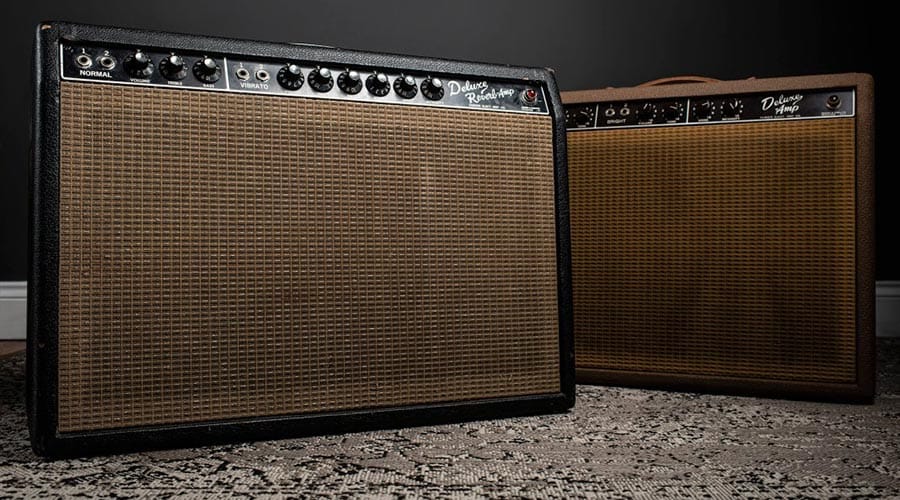
The Fender Deluxe Reverb is an amplifier that most guitar players are familiar with. The brainchild of Leo Fender, the Deluxe Reverb is an iconic amp that has been used by the biggest names in music. It has been called the most recorded amp in history, which is a claim that is hard to quantify but does not sound so outrageous that it is probably true.
Known for its ability to produce ultra clean and bright tones, it has been used by country pickers for years, but it is its saturated overdriven tones that helped build the foundation that so many classic rock guitarists have built their signature sound on. Many guitarists call the “Deluxe”, as it is affectionately known, their desert island amp of choice because of its versatility, good looks, and delicious sound.
Amp Specifications
The Deluxe Reverb is a two-channel amplifier sporting a foursome of 12AX7 vacuum tubes (or valves for those in Great Britian) along with a pair of 12AT7 tubes in the pre-amp section. The power section consists of a pair 6V6GTs along with a 5AR4 tube rectifier.
Called the AB763 schematic in house (created in July of 1963 – 763), this circuit is the pinnacle of circuit design regarding Fender amplifiers. Used in the Deluxe Reverb, Twin Reverb, Super Reverb, Bandmaster, Showman, Pro, Vibrolux, Vibroverb, Tremolux and the reverb-less Deluxe, its circuit helped shape the classic guitar sound for the last 70 years.
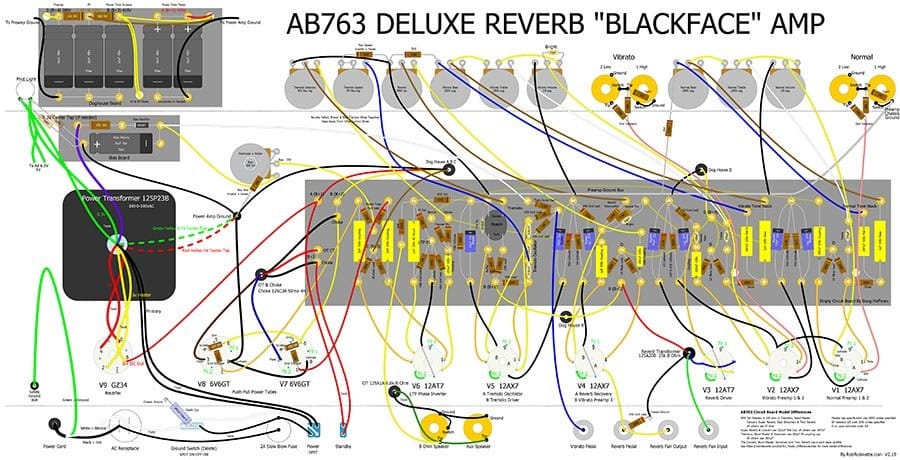
Channel one is a clean channel while channel two adds the reverb and tremolo effects into the circuit. The design of each channel’s circuit is essentially the same other than channel two, which adds in the vibrato and reverb effects into the signal chain. An additional pre-amp gain stage was added to make up for the signal loss caused by the reverb and vibrato circuits. This extra gain stage makes up for the signal loss and then some causing channel two to have more gain (volume) available than channel one.
The output transformer of the Deluxe Reverb is a little undersized which adds compression at high volumes. This compression creates increased sustain and sensitivity between the amplifier and the guitarist. With an undersized power transformer causing voltage lag, coupled with the compression and sustain caused by the undersized output transformer, the Deluxe Reverb has a little more rounded tone and sounds like a true tube (or valve) amplifier than any of its cousins listed above.
Having fixed bias power tubes allows the Deluxe Reverb to sound clean and punchy at high volumes than the other cathode-biased tube amps that preceded it. The breakup that happens when an amplifier is overdriven is more controllable in the Deluxe Reverb than it is in the early tweed models because of the design of the circuit. The early tweed units had a wide sloppy transition from clean tones to dirty overdriven tones, whereas the Deluxe Reverb’s circuit refines that transition where it leaps from clean to dirty at the touch of the guitarist.
The Deluxe Reverb tops out at 22 watts of power (equivalent to 80–100-watt solid state amplifier) coming through an onboard 8ohm 12” Jensen speaker; enough volume to fill a small ballroom or at least keep up with an overzealous drummer. At low volumes, the crystal-clear highs are bright and tight without losing the bass at the bottom end, but when the volume is pushed, the pre-amp tubes start to compress the signal, and the warm overdriven tones start to occur in a more manageable range.
Deluxe Origins 1946
Introduced in 1963, the Fender Deluxe Reverb began its legacy in music history. But its origin story actually started 17 years earlier. Leo Fender first introduced the “Woodie” to the guitar world in 1946, a two-channel tube amplifier aimed at the western swing guitarist of the day.
That amplifier looked a lot like a small television with wide front panels and a ribbed grill cloth. Inside the cabinet, a two-channel audio circuit with a pair of high/low inputs were powered through a 12” speaker. Sporting a 5Y3-GT rectifier and a pair of 6V6-GT power tubes, as well as a 12AY7 and a 12AX7 in the preamp, the circuit cranked out 15 watts of tube goodness.
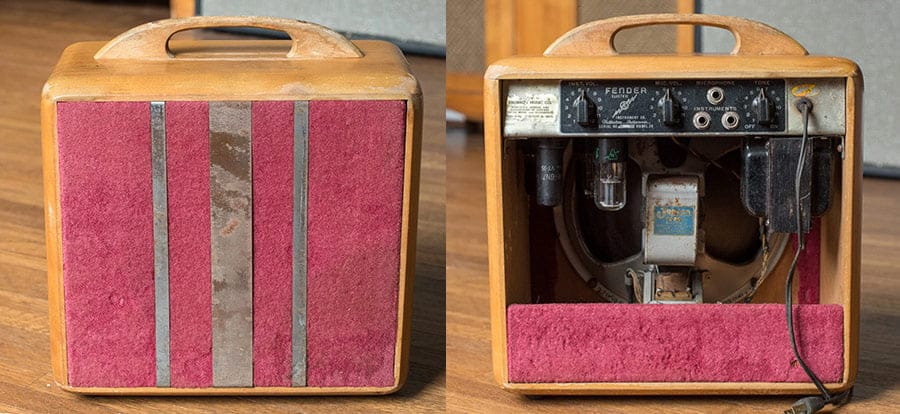
Tweed Deluxe: 1948-1959
In 1948 Leo changed the name of his creation to the “Deluxe,” and for that we are all thankful. Imagine having to carry a “woodie” to every gig or have the sound person ask you to turn up your “woodie” in front of the band. Thank you, Leo, for the name change.
Covered in cotton tweed, the “Tweed Deluxe” was produced from 1948 until 1959 when the Brownface Deluxe option debuted. Amplifiers of the tweed era are now considered “holy grail” amps and are sought after by gigging musicians and collectors the world over.
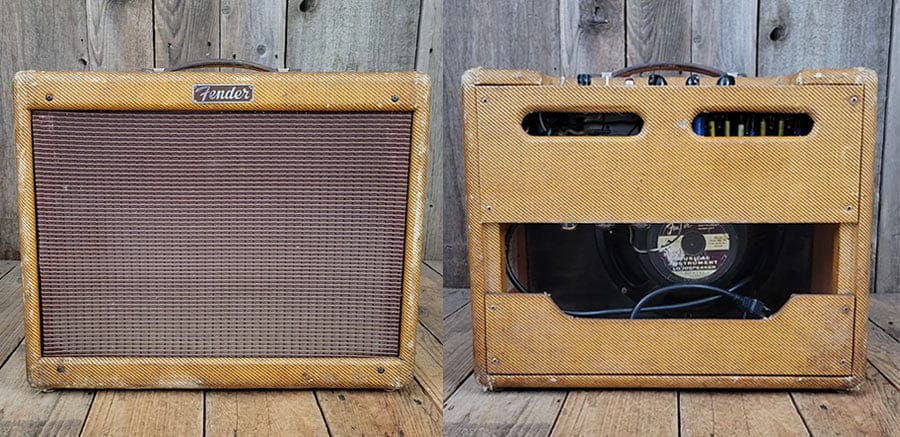
Brownface: 1959-1963
The circuit was also changed adding in a tremolo effect, individual tone controls for each input channel, and a phase inverter. A trio of 12AX7 pre-amp tubes were added to the circuit, as well as a more efficient GZ34 rectifier tube. The power tubes remained a pair of 6V6GT tubes, however, the bias structure was changed increasing the output of the amplifier to 20 watts.
Fender was constantly searching for an amplifier circuit that would allow the most available clean headroom before breaking into the overdriven distortion territory. The circuit change allowed the bottom end of the amp to be tightened up and gave the guitarist more control over the mid scoop, which was very evident in early Deluxe models. The new circuit design tamed the overdriven tones that came fast and furious through the earlier Tweed models but also created a more sterile clean sound which many guitarists did not love.
Although not as sought after as their Tweed predecessors, the Brownfaces still have a particular following in the guitar world for those looking for tight bass response and lots of clean headroom.
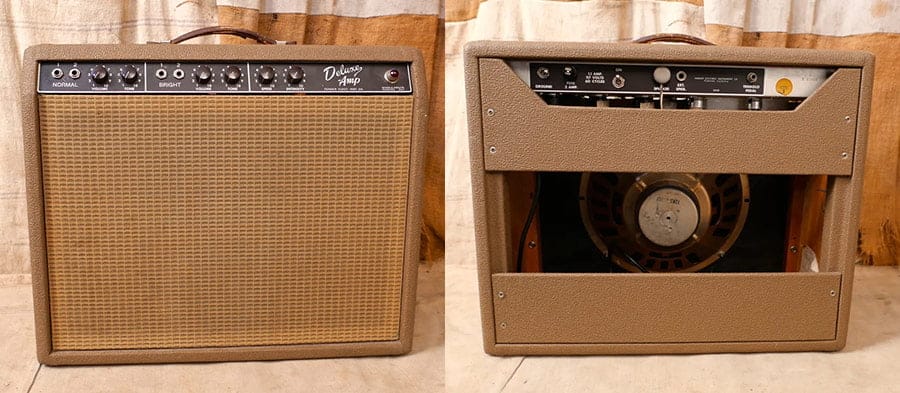
Blackface Deluxe: 1963-1966
In 1963, Fender changed the design of the Deluxe again, opting to replace the brown Tolex with black, ushering in the “Blackface” era. The color change was not the only change that occurred however, the knobs themselves saw a redesign adding the numbers directly onto the knob themselves.
The circuit was also redesigned, applying a single 12AX7 tube to each of the input channels, as well as the oscillator for the tremolo, and a 12AT7 used as a phase inverter.
Treble and bass controls were added for each channel instead of the single tone knob found on the previous units, hoping to allow the guitarist to dial in the tone they desired. A potentiometer was added on the back of the chassis to make tube biasing easier and the overall output increased to 22 watts.
The “Blackface Deluxe” falls into the same category as its “Brownface” older brother, desirable for a certain style of guitarist but still falling short of its older Tweed brothers in the popularity contests.
Blackface Deluxe Reverb: 1963-1967
The Deluxe saw a spinoff in 1963 when a spring reverb tank was added to the existing circuit. The black Tolex exterior remained, along with a black metal control panel with white lettering. Fender also added the tilt back legs to the sides of the unit, allowing the cabinet to be angled back for the working musician, and to spare those people sitting on the front rows of the venue from guitar overload. Cranking out 22 watts of power, the Deluxe Reverb Amp was a hit among guitarists.
The spring reverb was not a new idea in 1963 as Laurens Hammond of the Hammond Organ Company had invented a reverb using springs in the 1930’s, and incorporated them into their organs in the 1940’s. The 4-spring reverb unit was eventually licensed to other users, Fender being one of the first to use their creation.
Reverb is created when sound waves bounce off of hard surfaces. Mr. Hammond was able to utilize a number of springs attached to a transducer at one end that excited the spring with the audio signal causing them to vibrate. A pickup on the other end of the springs recorded the delayed signal, which mimicked the natural reverb reflections found in say a church or a large hall. The Hammond Type 4 Reverb was licensed for use by Fender in their amplifiers and the rest is musical history.
With the AB763 circuit perfected, reverb and tremolo added along with the undersized transformers, Fender finally found the sacred ground between the overdriven sounds of the Tweed and the refined cleans of the new Deluxe.
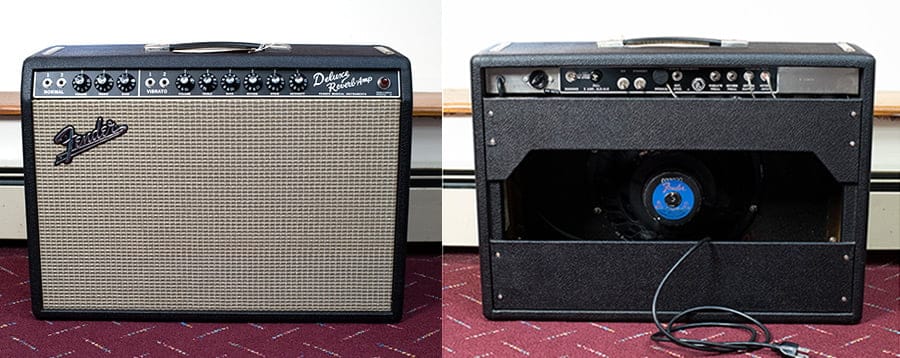
Silverface Deluxe Reverb: 1967-1980
In 1967, Fender made a slight cosmetic change to the Deluxe Reverb trading the white lettering on a black faceplate for an incandescent blue lettering on a silver faceplate. The black Tolex and the silver grill cloth remained unchanged as did the tilt back legs. Although the circuit remained the same on the early “Silverface” production models, many guitarists swear that the “Blackface” models sound better than the later “Silverface” models.
Looking at the circuitry, Fender was constantly striving to build an amplifier that had more clean headroom allowing for crystal clear bright tones at higher volumes before the tubes were driven to the point of distortion. The Silverface received a different power transformer and rectifier in 1968 to try to tame the distortion, but the overall circuit remained untouched from the previous Blackface models. The addition of the new transformer and rectifier might have changed the tone enough for the discerning guitarist to notice the difference.
Many of the larger amplifiers that Fender produced during the CBS era had major circuit changes during that time as well, however, the Deluxe Reverb escaped those issues and remained essentially unchanged until it was discontinued in 1982.
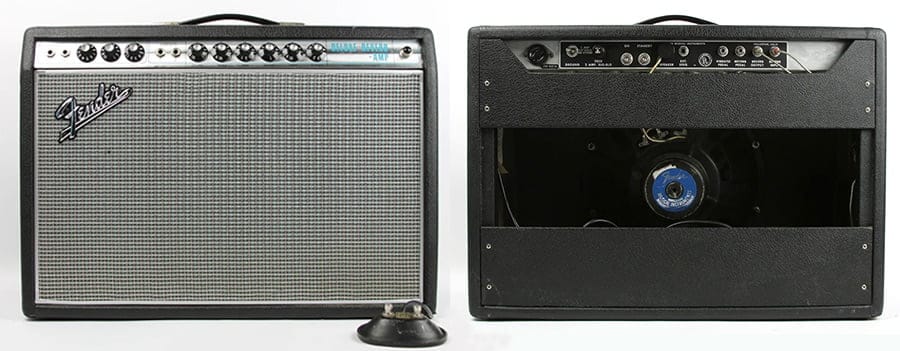
Blackface Deluxe Reverb: 1980-1982
All good things come back around for those that wait long enough, and the same can be said about the Blackface Deluxe.
In 1980, Fender decided to return to the original white lettering on a black faceplate. The decision to revert back to a black control plate is one of those mysteries that will remain through the years.
Was Fender trying to drive new sales as its Blackface amps had become collectible and the used prices were significantly higher than their new Silverface models? Did one of the Fender workers discover a box of black plates and they decided to use up stock instead of ordering new plates?
We may never know, but for two years Fender offered a Blackface Reverb with a little less lettering on the plate (instead of reading “Deluxe Reverb Amp”, the faceplate simply reads “Deluxe Reverb”) but with all of the same circuitry goodness found in the latest Silverface incarnation.
’65 Deluxe Reverb Reissue: 1993-Current
In 1993, Fender re-issued the ’65 Deluxe Reverb with the original black Tolex, black and white faceplate, and the original circuitry used in 1965. The main difference between the original being the circuit board was now printed instead of an eyelet hand-wired board like the originals.
The new design took into consideration the underpowered transformers and the rectifier tube from the original and tried to duplicate those aspects in the new design. From what I have heard, they did a pretty good job of making that happen.
Do You Hear What I Hear?
To my ears the original Blackface models from the 60’s sound more rounded and full-bodied tone-wise compared to the reissues. The reissues seem to have a brighter sound compared to the 50-year-old models and who knows, in another 50 years we may be saying the same thing about the reissues once they have had 50 years of gigging put on them.
The reissues also seem to have more headroom compared to the older versions, louder and tighter on the cleans which might be the result of a more efficient speaker compared to the older models.
You can listen to a comparison of a vintage Blackface versus a Blackface re-issue on the link below.
The ‘Deluxe’ Players
Players like Billy Gibbons of ZZ Top, The Edge of U2, Don Felder with the Eagles, and guitarists like Steve Cropper, Neil Young, Johnny Lang, and Eric Johnson, to name just a few, sport a Fender Deluxe on their backline. John Mayer originally used a trio of customized Deluxe Reverbs with his Stratocaster in his work with “Dead and Company” but has since navigated to other amplifiers.
Just like a great infomercial, “But wait, there’s more!”
In 2021, Peter Jackson of the “Lord of the Rings” movie fame directed and produced a three-part documentary on the most influential band (in my opinion) of all time. That documentary covered the making of the 1970 album “Let it Be” by the Beatles. Using original video and audio material captured by Michael Lindsay-Hogg for his 1970 documentary of the album, Jackson weaved the reclaimed footage into an engaging eight-hour biopic covering the greatest band of all time and titled it “Get Back”.
Catch this quick clip of the Beatles rooftop concert performing “Get Back” and notice the trio of Fender Deluxe amps on the backline used by John and George.
Conclusion
As musicians, we are always searching for better ways to connect with our listening audience. It is funny then to think that an electrical engineer, not a musician has had more to do with musicians connecting to their audiences than any other person in history.
Leo Fender’s creation in the world of amplifiers is a shining example of someone searching for a better way to transport music to the world. In this case, the box that transports the music is covered in black Tolex and has changed the sound of music forever.
So, do you go for an original “Silverface”, a “Blackface”, pick up a reissue, or one of the cousins that Fender produced using the AB763 schematic? That decision will come down to your playing style, budget, and what you want in an amplifier.
But for my money, there is very little difference tone-wise between the reissues and the original 1965 Deluxe Reverb. So, grab a re-issue and play it hard for the twenty years, I am sure that vintage tone will come through eventually.
Share this post with your friends using these one-click sharing options:
👉 Click here to share on Facebook.
👉 Click here to share on X.
👉 Click here to share on LinkedIn.
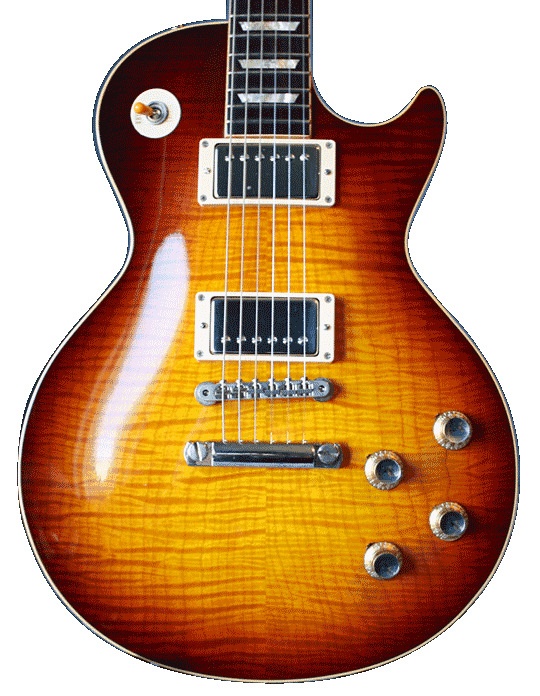
Get the latest reviews, guides and videos in your inbox.